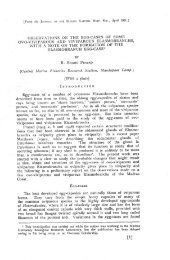PDF - Eprints@CMFRI
PDF - Eprints@CMFRI
PDF - Eprints@CMFRI
Create successful ePaper yourself
Turn your PDF publications into a flip-book with our unique Google optimized e-Paper software.
77<br />
reach the centre of the disc . A scar of attachment is not always visible. The first two cycles of septa stand<br />
very high around the axial fossa . Septal edges minutely toothed, sides with granules arranged in transverse<br />
rows.<br />
Distribution : Red Sea; Ceylon ; Tuticorin (PIll.AI, 1972); Andamans, icobars; Mergui Archi·<br />
pelago; East Indies; China Sea; Philippines; Honshu ; Palau Isis.; New Britain.<br />
Fungia<br />
eycioseris<br />
Fungia<br />
Cycloseris costulata (ORTMANN) , 1889<br />
(Plate 17. Figs. 1- 5)<br />
cortulata 1889. ORTMANN, S 19; pI. )4/8 (Type: locality: Ceylon).<br />
1902. DOEDERLEIN. 81; pis. 4/2, 2.; 517 , 7 •.<br />
1909, GARDINER. 271; pI. lS /9.<br />
1976, PILLAI & SCHEER, 42.<br />
1979, SCHUHMACHER, 212.<br />
1980, VERON & PICHON. 110; figs. 175 - 177.<br />
eyclalites 1905, GARDINER. 944 (pars); pI. 91119.<br />
1921 , v. d. HORST. 59 (pars); pI. 2/5.<br />
doederleini 1941 , YASE & SUGIYAMA. 77: pI. 66/ 9- 9d (non v. MARENZELLER, 1906).<br />
We do not have this species in our collection, we could only study one specimen from Dr. SCHUH<br />
MACHER.<br />
The disc is round, 48 mm in diameter, 20 mm high with an unusual thick margin . The central part is<br />
elevated and arched around the fossa . First two cycles of septa are clearly exsert towards the fossa , also<br />
the third cycle is still exsert. At the periphery the septa are equal. Septa of six cycles are present with<br />
some members of the seventh. Septa of higher orders unite with those of the fifth cycle, which get<br />
suddenly lower and rise again towards the fossa, but do not reach the former level. The dents, caused in<br />
this manner, form a conspicuous ring with a diameter of about 32 mm. Septa of the fourth cycle stop<br />
suddenly before reaching the fossa. Septal margins have very small irregular denticles.<br />
Costae of the underside with very small, secondarily frosted spines are equal, distinct and laminar.<br />
They extend as rows of granules to the centre, which is a rounded hillock of about 20 mm diameter. It<br />
has no sharp boundary, a scar of attachment is not visible.<br />
Mat e ria I: Gulf of Aqaba: SCHUHMACHER No. 214 (Eilat).<br />
Dis t rib uti 0 n : Red Sea ; Mozambique; Seychelles (WIJSMA -BEST, FAURE & PICHON , 1980);<br />
Maldives ; Ceylon; Palau Isis.; Bismarck Archipelago; Great Barrier Reef.<br />
Remarks : YABE & SUGIYAMA (1941) felt that F. costulata DOEOERLEIN , which is in reajiry a<br />
true Cycloseris , is not the same as F. costulata ORTMANN, 1899, and proposed a new name F. doederleini<br />
to DOEDERLEIN 's specimens. We do not know exactly, if ORTMANN 's and DOEDERLEIN 's material belong<br />
to a single species or not. However, it may be pointed out that the specific name doederleini, as applied<br />
by YABE & SUGIYAMA , is preoccupied by MARENZELLER's (1906) Fungia doederleini.<br />
Additional rem ark s on further species of Cye/oseris, reported from Red Sea:<br />
Fungia<br />
Cyclose,.is<br />
Cycloseris marginata ( BOSCHMA), 1923<br />
marginala 1923 . BOSCHMA , 141 : pis. 9/8 , 8a; 10/ 24- 26 (Type locaJiry : Paternoster Islands).<br />
"''"8inattl 1974, SCHEER & PILLAI , H i P!. 1714.<br />
1979, SCHUHMACHER, 210; figs. 4 (left), 21.<br />
1980, VERON & PICHON, 118 : figs. 192 , 193.<br />
SCHUHMACHER (J 979: 236) mentioned, besides the one we identified as C. cf erosa, four more<br />
speci mens of this species. VERON & PICHON (\980) say that C. marginata was recorded from the Red<br />
Sea. They surely refer to SCHUHMACHER, because no other worker has reported on this species from<br />
Red Sea.<br />
Fungia patella (E LLIS and SOLANDER ), 1786<br />
Fungia patella 1902. DOEDERLEIN, 65; pIs. 1; 2; 5/ 1. 2 (sy nonymy).
















